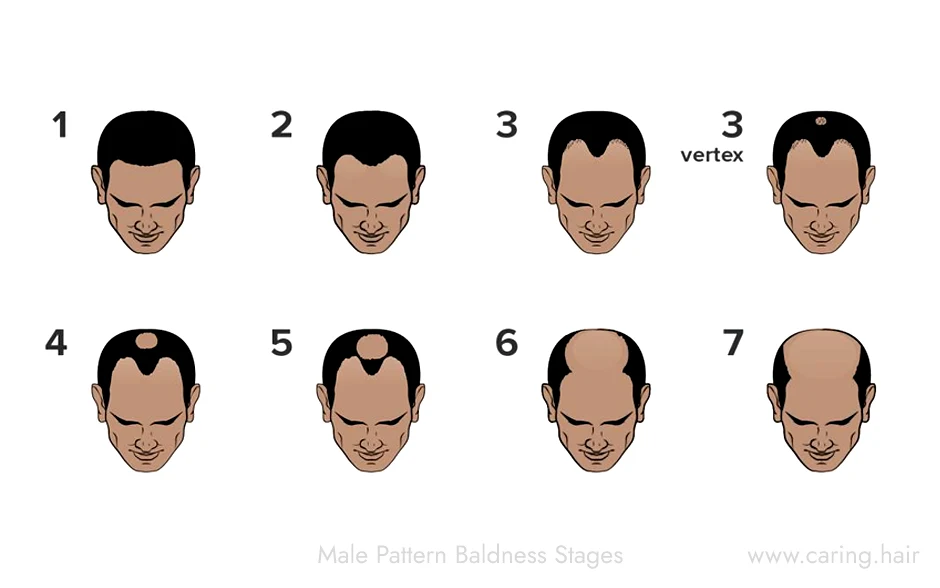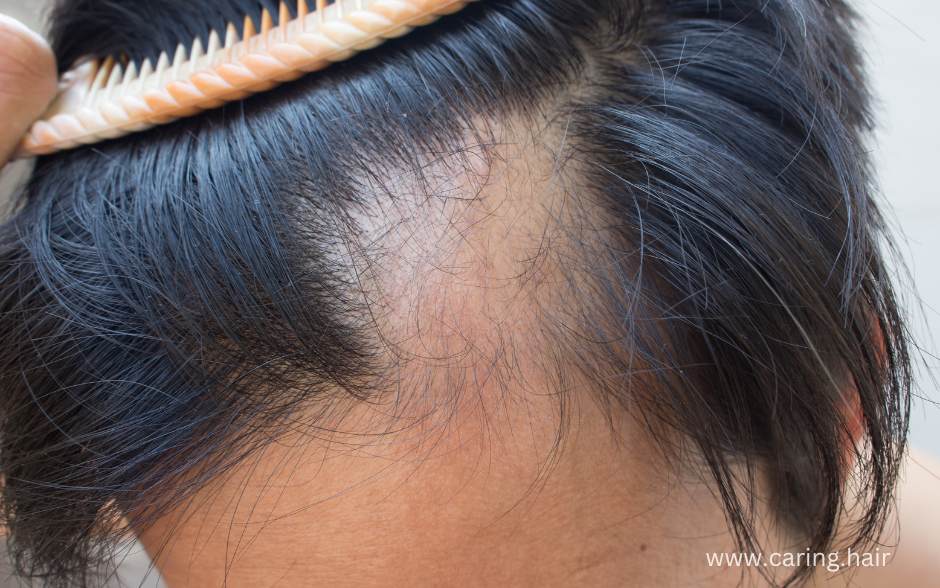Nothing quite compares to the feeling of looking in the mirror and realizing that your once-luxuriant head of hair has started to thin or recede. For many men, hair loss can be a frustrating and embarrassing experience that affects not just their appearance, but also their confidence and self-esteem. But don’t worry, you’re not alone!
Male pattern baldness is a common condition that affects millions of men worldwide. Fortunately, there are plenty of effective hair loss treatments available that can help you regrow your hair and feel like your old self again. In this article, we’ll take you through some of the best hair regrowth treatments for men, and provide you with practical advice on how to fight hair loss and restore your hair to its former glory.
I. Introduction
Male pattern baldness, also known as androgenetic alopecia, is a common condition that affects millions of men around the world. It is characterized by a gradual thinning of hair on the crown and/or hairline, and can eventually lead to complete baldness in some cases. While hair loss is a natural part of the aging process, male pattern baldness is caused by a combination of genetic and hormonal factors that can lead to premature hair loss.
According to the American Hair Loss Association, approximately two-thirds of men will experience some degree of hair loss by the age of 35, and by age 50, about 85% of men will have significantly thinning hair. Hair loss can have a significant impact on a man’s self-esteem, confidence, and overall quality of life, which is why seeking treatment is important.
In the following sections, we will explore the causes and types of hair loss in men, as well as the best treatments available for regrowing hair and preventing further loss.
II. Causes of Hair Loss in Men
1. Genetics and Heredity
Male pattern baldness is largely a hereditary condition, meaning it is passed down through family genetics. It is caused by the presence of the hormone dihydrotestosterone (DHT), which is a derivative of testosterone. DHT binds to hair follicles on the scalp and gradually causes them to shrink, leading to thinner and weaker hair. Men who have a family history of hair loss are more likely to develop male pattern baldness themselves.
2. Hormonal Changes
Aside from genetics, hormonal changes can also contribute to hair loss in men. As mentioned earlier, DHT is a hormone that plays a key role in male pattern baldness. When the body produces too much DHT, it can accelerate hair loss. Other hormones such as thyroid hormones, prolactin, and cortisol can also contribute to hair loss in men if they are produced in excess.
3. Age and Natural Hair Loss
As men age, it is natural for hair to thin and become weaker. This is due to a decrease in the production of hormones like testosterone and DHT. Additionally, hair follicles shrink with age, making it harder for hair to grow back once it falls out. Natural hair loss due to aging can be exacerbated by genetics or other health conditions.
4. Health Conditions
Certain health conditions such as autoimmune disorders, scalp infections, and thyroid problems can also cause hair loss in men. These conditions can disrupt the hair growth cycle and lead to hair loss.
5. Medications and Treatments
Some medications and treatments such as chemotherapy can cause hair loss as a side effect. Radiation therapy and some prescription medications can also contribute to hair loss in men.
Understanding the underlying causes of hair loss in men is important for determining the best course of treatment. In the next section, we will explore the different types of hair loss that men can experience.
III. Types of Hair Loss in Men
1. Male Pattern Baldness

Male pattern baldness is the most common type of hair loss in men, accounting for approximately 95% of cases. It is characterized by a receding hairline and thinning hair on the crown of the head. Male pattern baldness typically begins with a receding hairline at the temples, followed by thinning hair on the top of the head. Over time, the hairline can recede to form an “M” shape and eventually progress to complete baldness.
2. Alopecia Areata

Alopecia areata is an autoimmune disorder that causes hair loss in patches on the scalp. The condition occurs when the body’s immune system attacks hair follicles, causing them to shrink and produce less hair. Alopecia areata can affect men of any age, but it typically begins in childhood or early adulthood.
3. Telogen Effluvium
Telogen effluvium is a type of hair loss that occurs when a large number of hair follicles enter the resting phase of the hair growth cycle at the same time. This can be triggered by a variety of factors, including stress, illness, medications, and hormonal changes. Telogen effluvium can cause temporary hair loss that typically resolves on its own within a few months.
4. Traction Alopecia
Traction alopecia is a type of hair loss that occurs when hair is pulled tightly for extended periods of time, causing damage to hair follicles. This can be caused by tight hairstyles such as braids, ponytails, or cornrows, and is more common in men who frequently wear their hair in these styles.
5. Scarring Alopecia
Scarring alopecia is a type of hair loss that occurs when hair follicles are destroyed and replaced with scar tissue. This can be caused by a variety of factors, including autoimmune disorders, infections, and burns. Scarring alopecia can lead to permanent hair loss.
Understanding the different types of hair loss in men is important for determining the best course of treatment. In the next section, we will explore the best hair loss treatments available for men.
IV. Best Hair Loss Treatments for Men
1. Minoxidil
Minoxidil is an over-the-counter medication that is FDA-approved for treating hair loss in men. It works by increasing blood flow to the hair follicles, which can stimulate hair growth. Minoxidil is available as a topical solution or foam, and is typically applied directly to the scalp twice daily. It can take several months of regular use to see results, and the medication must be continued in order to maintain hair growth.
2. Finasteride
Finasteride is a prescription medication that is FDA-approved for treating male pattern baldness. It works by blocking the production of DHT, which can slow or even reverse hair loss in men. Finasteride is taken orally, usually once daily. It can take several months of regular use to see results, and the medication must be continued in order to maintain hair growth.
3. Low-Level Laser Therapy
Low-level laser therapy (LLLT) is a non-invasive treatment that uses red or near-infrared light to stimulate hair growth. It is thought to work by increasing blood flow to the hair follicles and stimulating cell metabolism. LLLT can be administered via a handheld device, helmet, or in-office treatment. Results may vary, and regular treatments are required to maintain hair growth.
4. Hair Transplant Surgery
Hair transplant surgery involves transplanting hair follicles from one part of the scalp to another. The procedure can be performed using either follicular unit transplantation (FUT) or follicular unit extraction (FUE) techniques. Hair transplant surgery is typically reserved for men with advanced hair loss who are not candidates for other treatments.
5. Lifestyle Changes
Making lifestyle changes such as eating a healthy diet, exercising regularly, and reducing stress can also help to slow or prevent hair loss in men. Adequate protein intake is especially important for promoting healthy hair growth, as hair is primarily made up of protein.
It is important to note that not all hair loss treatments work for everyone, and some may have side effects or require ongoing maintenance. It is best to consult with a healthcare professional to determine the best course of treatment for your individual needs.
V. Natural Remedies for Hair Loss in Men
While there are several medical treatments available for hair loss in men, some people prefer to try natural remedies first. Here are some natural remedies that may help to prevent or slow down hair loss:
1. Saw Palmetto

Saw palmetto is a natural remedy that is often used to treat male pattern baldness. It is believed to work by blocking the production of DHT, a hormone that can contribute to hair loss in men. Saw palmetto can be taken as a dietary supplement or applied topically to the scalp.
2. Aloe Vera
Aloe vera is a plant that is often used to soothe skin and promote healing. It may also help to stimulate hair growth by increasing blood circulation to the scalp. Aloe vera gel can be applied directly to the scalp and left on for several hours before rinsing.
3. Essential Oils
Essential oils such as lavender, peppermint, and rosemary may help to promote hair growth by increasing blood circulation to the scalp and stimulating hair follicles. They can be applied topically to the scalp in a carrier oil such as coconut oil or mixed with a shampoo or conditioner.
4. Scalp Massage
Massaging the scalp can help to increase blood flow to the hair follicles and stimulate hair growth. Use your fingertips to massage the scalp in a circular motion for several minutes each day.
5. Healthy Diet
Eating a healthy diet that is rich in vitamins and minerals can help to promote healthy hair growth. Some nutrients that are particularly important for hair health include protein, biotin, zinc, and iron. Incorporate foods such as lean meats, eggs, nuts, and leafy greens into your diet to support healthy hair growth.
While natural remedies can be a good first step in addressing hair loss, it is important to note that they may not be as effective as medical treatments. It is best to consult with a healthcare professional to determine the best course of treatment for your individual needs.
VI. Tips for Preventing Hair Loss in Men
While there are several treatments available for hair loss in men, prevention is always the best course of action. Here are some tips for preventing hair loss:
1. Practice Good Hair Care
Proper hair care can help to prevent damage to the hair and scalp, which can contribute to hair loss. Avoid harsh chemicals and heat styling tools, and use a gentle shampoo and conditioner to keep hair healthy.
2. Protect Your Scalp from the Sun
Just like your skin, your scalp can be damaged by the sun’s UV rays. Wear a hat or use a sunscreen specifically formulated for the scalp to protect your hair and scalp from damage.
3. Manage Stress
Stress can contribute to hair loss in men, so it is important to find ways to manage stress levels. Exercise, meditation, and deep breathing exercises can all help to reduce stress and promote overall health.
4. Get Enough Sleep
Getting enough sleep is important for overall health, including hair health. Aim for 7-8 hours of sleep per night to help promote healthy hair growth.
5. Quit Smoking
Smoking can contribute to hair loss in men, so quitting smoking can help to prevent or slow down hair loss. If you need help quitting, talk to your healthcare provider or a support group.
By following these tips, you can help to prevent or slow down hair loss in men. It is important to remember that not all hair loss can be prevented, and some people may require medical treatment to address their hair loss. If you are concerned about hair loss, it is best to consult with a healthcare professional to determine the best course of action for your individual needs.
VII. Hair Products Brands
Here are some hair products that have shown to be effective in promoting hair growth and reducing hair loss:
- Finasteride (Propecia): Finasteride is a prescription medication that is used to treat male pattern baldness. According to a study published in the Journal of the American Academy of Dermatology, finasteride was found to be effective in promoting hair growth in men with mild to moderate hair loss.
- Minoxidil (Rogaine): Minoxidil is an over-the-counter medication that is used to treat hair loss. A study published in the Journal of the American Academy of Dermatology found that minoxidil was effective in promoting hair growth in men with androgenetic alopecia, the most common form of hair loss in men.
- HairMax LaserComb: The HairMax LaserComb is a handheld device that uses low-level laser therapy to stimulate hair growth. According to a study published in the International Journal of Trichology, the HairMax LaserComb was found to be effective in promoting hair growth in men with androgenetic alopecia.
- Nizoral Shampoo: Nizoral Shampoo contains ketoconazole, an antifungal medication that is also known to have anti-androgenic effects. According to a study published in the Journal of Dermatology, Nizoral Shampoo was found to be effective in reducing scalp inflammation and promoting hair growth in men with androgenetic alopecia.
- Biotin Supplements: Biotin, also known as vitamin H, is a B vitamin that is important for healthy hair growth. According to a review article published in the Journal of Drugs in Dermatology, biotin supplements may help improve hair thickness and reduce hair shedding in some individuals.
VIII. Conclusion
Hair loss can be a distressing condition for men, but there are several effective treatments available. From medical treatments like finasteride and minoxidil, to natural remedies like saw palmetto and aloe vera, there are a variety of options for addressing hair loss. Additionally, taking steps to prevent hair loss, such as practicing good hair care, protecting the scalp from the sun, managing stress levels, getting enough sleep, and quitting smoking, can help to promote healthy hair growth.
If you are concerned about hair loss, it is important to consult with a healthcare professional to determine the best course of action for your individual needs. With the right treatment and care, it is possible to slow down or even reverse hair loss, helping men to regain their confidence and feel good about their appearance.
FAQs
What causes male pattern baldness, and is it preventable?
Male pattern baldness is primarily caused by genetics and hormonal changes, making it difficult to prevent. However, there are some lifestyle factors that can contribute to hair loss, such as smoking and poor nutrition. Making healthy lifestyle choices can help reduce the risk of hair loss and promote healthy hair growth.
What are the most effective hair loss treatments for men?
The most effective hair loss treatments for men include prescription medications like finasteride and minoxidil, hair transplant surgery, and low-level laser therapy. Natural remedies like saw palmetto and pumpkin seed oil may also be helpful in promoting hair growth.
Are there any natural remedies for hair loss that really work?
While more research is needed to confirm their effectiveness, some natural remedies like saw palmetto, pumpkin seed oil, and essential oils may help promote hair growth and slow down hair loss.
How long does it take to see results from hair loss treatments?
The time it takes to see results from hair loss treatments can vary depending on the type of treatment used. Prescription medications like finasteride and minoxidil may take several months to show noticeable results, while hair transplant surgery can provide immediate results.
Can stress cause hair loss in men?
Yes, stress can be a contributing factor to hair loss in men. When the body is under stress, it can trigger hormonal changes that lead to hair loss. Managing stress through exercise, relaxation techniques, and therapy can help reduce the risk of hair loss.
How does hair transplant work?
Hair transplant is a surgical procedure that involves taking hair follicles from one part of the body (typically the back or sides of the head) and transplanting them to the balding or thinning areas of the scalp. The transplanted hair follicles will then grow hair in the new location.
Is hair transplant a permanent solution?
Hair transplant can provide a permanent solution for hair loss, but it’s important to note that not all transplanted hair follicles will survive. Additionally, hair loss may continue to occur in other areas of the scalp that were not treated with the transplant. To maintain the results of a hair transplant, some individuals may require multiple procedures or additional hair loss treatments. It’s important to discuss the potential risks and benefits of hair transplant with a qualified healthcare professional.
when should men start taking hair loss treatment?
When it comes to hair loss treatment, starting early is key to improving the chances of success. According to the American Academy of Dermatology, hair loss is easier to treat when caught early, and medications such as finasteride and minoxidil have been shown to be effective in slowing or stopping hair loss in many men. It’s important to note that the success of treatment varies depending on the individual and the cause of their hair loss.
References:
Gupta AK, Charrette A. “The efficacy and safety of 5α-reductase inhibitors in androgenetic alopecia: a network meta-analysis and benefit-risk assessment of finasteride and dutasteride.” Journal of Dermatological Treatment, vol. 31, no. 4, 2020, pp. 354-366. https://doi.org/10.1080/09546634.2019.1649390
Rossi A, Anzalone A, Fortuna MC, et al. “Multicenter randomized trial of a hair loss supplement in women and men with androgenetic alopecia.” Journal of Cosmetic Dermatology, vol. 19, no. 3, 2020, pp. 533-539. https://doi.org/10.1111/jocd.13188
Yamazaki M, Miura Y, Tsuboi R. “Effects of saw palmetto extract on androgenic activity.” Journal of Dermatological Science, vol. 66, no. 1, 2012, pp. 35-42. https://doi.org/10.1016/j.jdermsci.2012.01.001
Lee BH, Lee JS, Kim YC. “Hair growth-promoting effects of lavender oil in C57BL/6 mice.” Toxicological Research, vol. 32, no. 2, 2016, pp. 103-108. https://doi.org/10.5487/TR.2016.32.2.103
Pazyar N, Yaghoobi R, Ghassemi MR, et al. “Aloe vera: A review of efficacy and safety.” Journal of Clinical and Aesthetic Dermatology, vol. 6, no. 2, 2013, pp. 26-29. https://www.ncbi.nlm.nih.gov/pmc/articles/PMC3551117/
